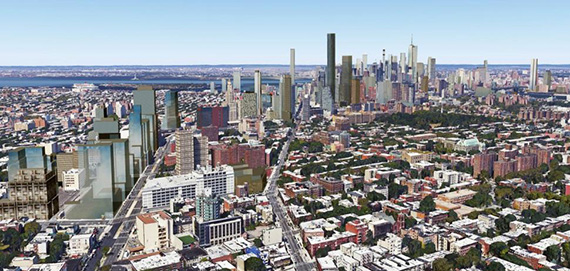Trending
Downtown Brooklyn’s second act: Q&A, Part II
CPEX's Timothy King and Stahl's Roger Fortune weigh in

From the May issue: The buzz surrounding Downtown Brooklyn’s skyline has lately reached a fever pitch. Last year, JDS and the Chetrit Group unveiled plans to build Brooklyn’s tallest tower, a 73-story residential skyscraper that would be twice as high as anything surrounding it. The investment represents a stark contrast to where the neighborhood was just over a decade ago.
Read on for the second installment of our Q&A on Downtown Brooklyn with Timothy King of CPEX Real Estate and Roger Fortune of the Stahl Organization.
Timothy King
Founder/managing partner, CPEX Real Estate
What kind of statement does the arrival of a supertower make about the neighborhood and where it’s headed?
It was simply a matter of timing and pricing. When we moved into our building at 81 Willoughby Street, The Brooklyner was the tallest building in Brooklyn. A few years later it was Stahl’s 388 Bridge, a year later, Avalon Bay Willoughby West. The JDS project is special. It includes the iconic landmarked Dime Savings Bank building at 9 DeKalb, which will be a very special retail venue. If you look at the combined acquisition costs for the Flatbush and DeKalb properties, take into consideration the dollar cost average by backing out the retail and stacking the air rights. I’m sure JDS and the Chetrit Group are very comfortable with their basis. These are smart guys with proven track records
of executing.
How much are rents up by in the last few years and how does that compare to other neighborhoods? Is there room for more growth or will rents plateau as new product comes on line?
Rents are above $60 per square foot and climbing. When Downtown Brooklyn was rezoned, the rental market was probably $35 per square foot. When the market crashed, we had a shortage of rental units and the market quickly went from $40 to $50 and steadily climbed from there. Rents will grow across the board another 6% to 10%. It’s important to consider unit sizes as well. The five highest rental markets in Brooklyn are Brooklyn Heights, Williamsburg, Dumbo, Downtown Brooklyn and the Heights. The top three are supply constrained.
How much have land/development prices in Downtown Brooklyn risen over the last few years and how does that compare with the rest of the city?
At the height of the last cycle we saw one site sold for north of $200 per square foot and it was a small site, around 60,000 square feet. At the time the market was $115 to $150 per square foot. We’ve now seen trades that eclipse $400 per square foot with at least one close to $500. But to assess this fairly you have to bifurcate the deals and back out the retail because in some instances the retail is projected to command $200 to $300 per square foot. Essentially the market is double where it was before the crash. We’ve seen similar growth in Manhattan, Long Island City and Astoria, Queens. But it’s hard to generalize.
You represented the sellers in the deal in 2014 to sell 420 Albee Square to JEMB Realty. What do you think of the firm’s decision to switch its plans to office from residential?
Firstly, I am proud that CPEX brokered the trade to JEMB. Here’s the thing, different investors have different investment preferences, hence that’s why our professionals are on teams that sell a particular type of real estate, i.e., office, industrial, retail, residential, multi-family and mixed-use. JEMB is more retail- and office-focused than residential. You have to weigh different factors here. They are already testing the market to get a feel for the demand, pricing and may even have some signed leases before putting a shovel in the ground. If office rents are in the $50 to $60 range, with ICAP tax abatement, it’s not so surprising to see JEMB choose office over residential. It means lower construction costs and more efficient floorplates, among other incentives.
In November, Adam America Real Estate and Slate Property Group teamed up with Chinese real estate giant China Vanke to build a $50 million, 33-story condo tower in Downtown Brooklyn. And of course, the China-based Greenland Group has a 70 percent stake in the residential portion of Pacific Park. Do you think Chinese investors will pull back in light of China’s market turmoil?
As long as EB-5 exists and the U.S. remains a safe haven, foreign investors will continue to invest in gateway cities.
Roger Fortune
Vice president, Stahl Organization
Stahl’s Condo Project 388 Bridge Street opened in 2014 to strong sales. What kind of buyers and renters have been flocking there and how has this changed over the last few years?
In 2014, buyers at 388 Bridge Street were most likely to be young professional singles and couples without children. In 2015, an increasing number of buyers were families with young children. The building has also attracted foreign buyers seeking a home in New York as well as empty nesters. 388 offers the design, quality and amenities of luxury Manhattan condominiums but with amazing views and light.
Aside from the Barclays Center, what projects have been game changers in the neighborhood?
City Point creates a major destination for food, entertainment and shopping in Downtown Brooklyn that will be unlike any other, while Brooklyn Bridge Park creates a destination for sailing, sports, families and food. The BAM Cultural District’s multiple new developments — particularly Theatre for a New Audience & BAM South — help make a great neighborhood even better.
In general, what are the infrastructure and public space improvements that will be key to the future of Downtown Brooklyn?
Willoughby Square Park is a crucial component of the “greening” of Downtown Brooklyn — creating open space for residents, shoppers and office workers in the neighborhood.




